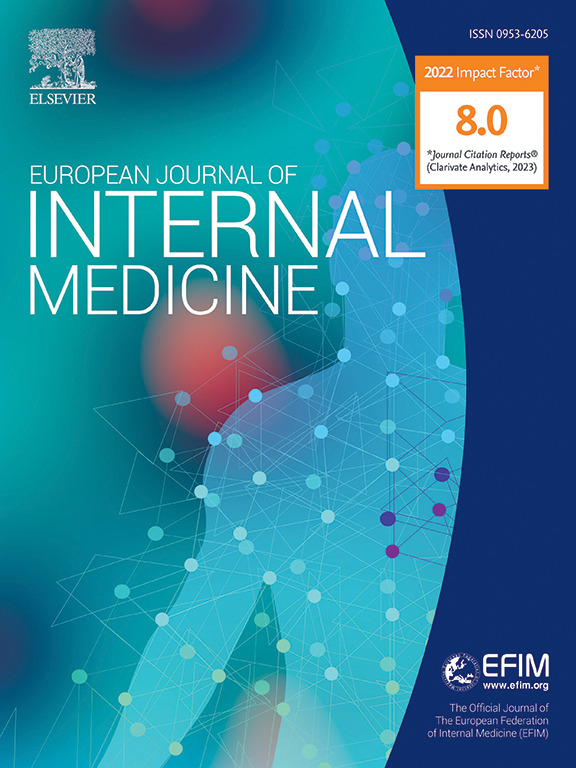Clinical characteristics and outcomes of Takotsubo syndrome in patients with chronic obstructive pulmonary disease
IF 5.9
2区 医学
Q1 MEDICINE, GENERAL & INTERNAL
引用次数: 0
Abstract
Background
takotsubo syndrome (TTS) is an acute heart failure syndrome characterized by a relevant comorbid background, including chronic obstructive pulmonary disease (COPD). However, TTS patients with COPD are still not well characterized.
Aim
to describe the clinical characteristics and outcomes of patients with TTS and COPD.
Methods
n = 440 TTS patients were dichotomized according to the presence of COPD. Endpoint of the study were in-hospital complications (composite of death, major arrhythmias, cardiogenic shock and acute pulmonary edema), TTS recurrence and long-term mortality at follow-up.
Results
mean age of the population was 72±11, 10 % males. COPD prevalence was 16 % (n = 69). On subgroup analysis, patients with COPD were more likely smokers (41 % vs 13 %, p < 0.001), with higher rates of dyspnea and physical triggers at presentation (52 % vs 18 %, p < 0.001 and 52 % vs 32 %, p = 0.001 respectively) and lower left ventricular ejection fraction (36 % vs 39 %, p = 0.035) In-hospital complications were more common in patients with COPD (26 % vs 13 %, p = 0.006), driven by higher rates of acute pulmonary edema (19 % vs 6 %, p < 0.001) and cardiogenic shock (10 % vs 4 %, p = 0.023). At multivariable logistic regression analysis, COPD was independently associated with in-hospital complications occurrence (Odds Ratio 2.10, 95 % CI 1.09–4.05; p = 0.027). At univariable Cox regression analysis COPD was associated with TTS recurrence (Hazard Ratio (HR 9.82, 95 % CI 3.2–30.12; p < 0.001)), at multivariable Cox regression analysis with long-term mortality (HR 2.97, 95 % CI 1.44–6.12; p = 0.003).
Conclusion
COPD marks a vulnerable TTS phenotype including higher risk of in-hospital complications, long-term recurrence and mortality.
慢性阻塞性肺病患者塔克次氏综合征的临床特征和预后。
背景:Takotsubo 综合征(TTS)是一种急性心力衰竭综合征,具有相关的合并症背景,包括慢性阻塞性肺疾病(COPD)。目的:描述 TTS 和 COPD 患者的临床特征和预后。方法:根据是否存在 COPD 对 n = 440 名 TTS 患者进行二分法。研究终点为院内并发症(死亡、严重心律失常、心源性休克和急性肺水肿的综合)、TTS复发和随访时的长期死亡率。慢性阻塞性肺病发病率为 16%(n = 69)。亚组分析显示,慢性阻塞性肺病患者更可能是吸烟者(41 % vs 13 %,p < 0.001),发病时呼吸困难和身体诱因的比例更高(分别为 52 % vs 18 %,p < 0.001 和 52 % vs 32 %,p = 0.001),左心室射血分数更低(36 % vs 39 %,p = 0.035)慢性阻塞性肺病患者的院内并发症更常见(26 % vs 13 %,p = 0.006),原因是急性肺水肿(19 % vs 6 %,p < 0.001)和心源性休克(10 % vs 4 %,p = 0.023)的发生率更高。在多变量逻辑回归分析中,慢性阻塞性肺病与院内并发症的发生有独立关联(Odds Ratio 2.10,95 % CI 1.09-4.05;p = 0.027)。在单变量 Cox 回归分析中,慢性阻塞性肺病与 TTS 复发相关(危险比 (HR 9.82, 95 % CI 3.2-30.12; p < 0.001)),在多变量 Cox 回归分析中与长期死亡率相关(HR 2.97, 95 % CI 1.44-6.12; p = 0.003):结论:慢性阻塞性肺病标志着一种脆弱的 TTS 表型,包括较高的院内并发症、长期复发和死亡率风险。
本文章由计算机程序翻译,如有差异,请以英文原文为准。
求助全文
约1分钟内获得全文
求助全文
来源期刊
CiteScore
9.60
自引率
6.20%
发文量
364
审稿时长
20 days
期刊介绍:
The European Journal of Internal Medicine serves as the official journal of the European Federation of Internal Medicine and is the primary scientific reference for European academic and non-academic internists. It is dedicated to advancing science and practice in internal medicine across Europe. The journal publishes original articles, editorials, reviews, internal medicine flashcards, and other relevant information in the field. Both translational medicine and clinical studies are emphasized. EJIM aspires to be a leading platform for excellent clinical studies, with a focus on enhancing the quality of healthcare in European hospitals.

 求助内容:
求助内容: 应助结果提醒方式:
应助结果提醒方式:


